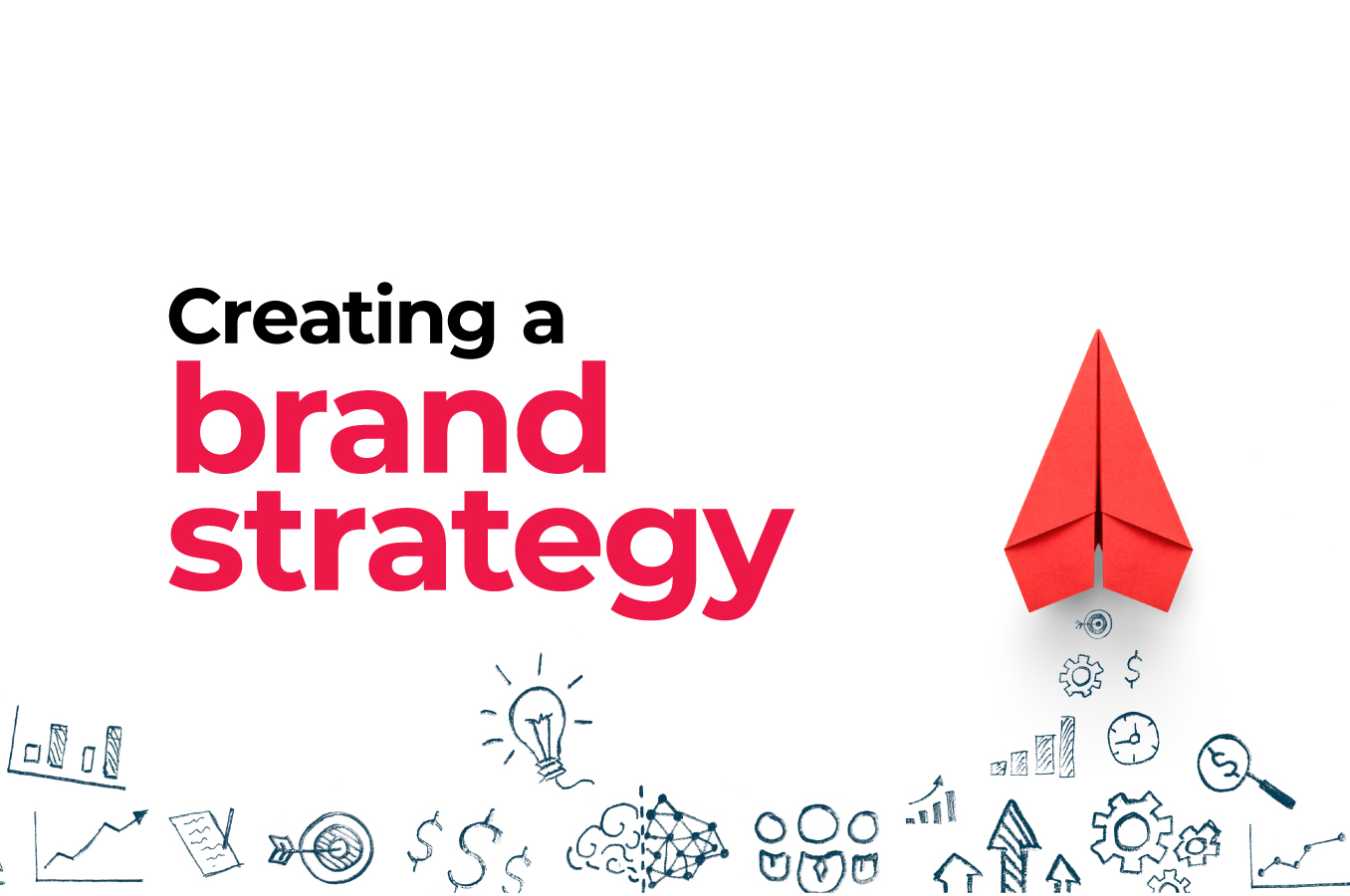Introduction
There are several key elements that you need to consider when developing a successful brand strategy. A whole team of people will get involved with setting goals, priorities and formalising actions including leadership teams, brand managers, marketers and agency creatives like us.
Used as a road map to guide company designs, marketing and communications, it’s essential the right steps are taken to find your brand’s most enduring value alongside what makes your organisation different, how and why you should position your products or services in a certain way and what your key messaging and communication goals should be.
This short blog post speaks to brand strategists, brand managers, marketers and business owners who are tasked with brand management. It’s will take approximately five minutes to read so grab yourself a drink and settle in.
Creating a brand strategy that works
Building a brand that matters is not an easy task. Good brand managers acknowledge brands as long-term business assets, not neglected logos or short-term marketing tactics that deliver quick turnover. Instead, they know brand management is a long-term game.
Utilising a brand as an asset’ relies on brand-building work that leverages your company’s image, purpose, culture and personality to march you towards achieving your business goals – such as improving your bottom line, attracting a talented workforce or doing something good with any profits you make.
But essentially, no two brands can be the same. Each has its unique identity that brand managers and business owners will use to create points of difference. Many of our clients gain and keep market share by engraining their brand values and brand personality to develop long-lasting relationships with your customers.
Whilst performance marketing should feature often throughout the year to stimulate sales, our clients also run consistent brand campaigns to build a sturdy platform for ongoing success.
Building your brand strategy
To develop an effective brand strategy, you need to acknowledge your vision, advance organisational goals and objectives, allow it to emerge from your values and culture and tailor it to meet the needs of your ideal customers.
Let your brand strategy become a central, unifying idea which aligns staff behaviour, company actions and all marketing communications. It’s also important to consider the needs and challenges of every department for branding to work seamlessly across all products and services.
Create a road map that guides people and allows them to understand what your brand strives to be. And don’t forget that your brand strategy needs to resonate with everyone. If your staff don’t believe in your vision, your customers won’t.
So a quick recap before we move on. Firstly, your brand strategy must acknowledge your company vision and advance your business goals. When this is cemented, tailor your thinking to meet the needs of your ideal customers, focusing on key product and service offerings and what you want customers to see and feel when they interact with your brand.
Once ideas start to take shape, you must recognise and carefully consider where you currently stand compared to your competition and consumer expectations.
Designing your brand identity
After establishing the brand goals, your next step focuses on creating a unique brand identity. Design work at this stage includes the creation of a brandmark or a logo and defining colour palettes, fonts, tone of voice, image usage and overall guidance around all written and visual communication tools needed to represent your brand. Any design choices made show clearly show your brand personality and brand positioning.
Our designers carefully evaluate and plan how your branding is presented across different media platforms (print and digital). Colour choices, typography and visual marks should become a unified brand identity that customers, staff and other stakeholders can easily recognise and remember.
There are other brand elements to take into consideration at this stage. For example, deciding what message you want to be associated with your brand. It should reflect the core values you want to communicate with your customers whilst marketing key services or products.
Focus on increasing brand equity
In addition to developing a unique identity and voice, you should also focus on increasing brand equality, which refers to the value of a brand in terms of customer loyalty, recognition and trust. With all communication, you should create a positive and lasting impression. Examples include investing in high-quality customer service and creating authentic brand touchpoints that are much more than flogging a product or service.
Optimising brand awareness
Brand awareness refers to how much exposure a company receives from potential customers. For any business, having a higher level of brand awareness is essential for success, as it allows customers to recognise and recall their products or services easily.
One way we increase brand awareness is by using powerful imagery or graphics associated with the company using thoughtful designs that stand out from competitors. Creating content focusing on customer stories, industry news and interesting facts about your organisation can help attract attention and drive engagement with ideal customers.
Leveraging social media for brand promotion
Social media remains one of the most powerful tools for promoting brands. Companies can use social media platforms such as Facebook, Twitter, Instagram, LinkedIn, TikTok and YouTube to reach consumers at scale. Harnessing the power of outreach, sponsored posts, influencers and platform advertising to reach even more people.
Social media provides opportunities to interact directly with your customers in real time, allowing you to engage in social listening as conversations in the comments unfold. Taking note of what people say about your brand can give you a rich data source straight from the horse’s mouth. Use it to get measures of customer loyalty, brand likeability and people’s willingness to recommend you.
Our human brains respond to brand messages in two ways; emotionally and intellectually. To get them interested in your brand, you must create content that facilitates an instinctive, fast emotional response backed up with secondary messages that allow them to think and mull over your service or product offering. Generally, there is no one-all-or-nothing magic brand message that seals the deal. Instead, ensure your brand strategy gives content creators the flexibility to create a series of connected messages at different stages of the buying journey.
Enhancing brand engagement
Engaging with customers often will help you build strong relationships that further enhance your brand presence in the marketplace. Responding quickly to customer enquiries, offering personalised recommendations and creating relevant and helpful marketing are examples. Loyalty programmes, discounts or referral incentives can also keep customers loyal to your brand. It is useful to know as case studies show that retaining customers costs less than finding new ones.
By constantly engaging with your customers on social media channels or through email campaigns, for example, businesses can ensure that they remain top-of-mind for prospects when they need the type of product, experience or service you offer. It also helps maximise customer retention, as existing clients will feel valued and respected by you, their preferred companies.
Tracking your brand performance
Finally, it isn’t easy to measure brand performance. But with that said, you should try and measure the performance of your branding for two reasons; to fine-tune your campaigns and determine ROI (return on investment).
Key performance indicators such as the number of customers allow you to see how good you are at attracting and retaining customers. Recency also tracks the time since their last purchase, indicating how active your customers are. Share of Voice quantifies the advertising presence of your brand or campaign with the total amount of advertising in a market to measure the relative strength of how your brand performs against others.
Another set of interesting metrics to discover includes the Hierarchy of Effects, which look at people’s awareness, attitudes, beliefs and intentions to buy. Gathering this kind of data requires you to put SMART advertising and marketing objectives in place to understand the progress made at each stage of the customer decision-making process.
Other measures to analyse brand performance include relative market share, brand development index, customer satisfaction, loyalty and willingness to recommend. No single set of data metrics will be perfect, so create a metrics dashboard relevant to measure your strategy’s success.
By understanding customer trends and having clear insights into how their campaigns are performing, businesses can innovate strategies and consistently ensure optimal returns on investment.



















